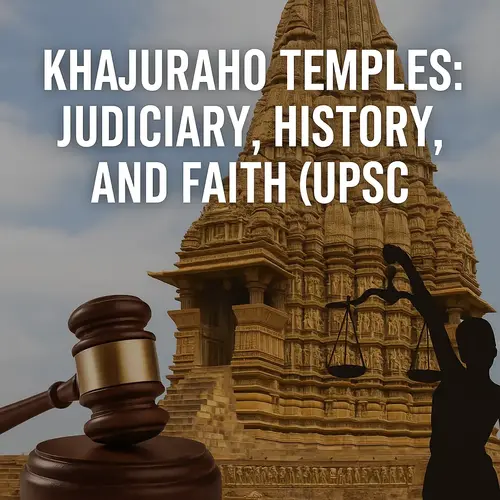
Introduction- Khajuraho temples met Judiciary
Recently, intense debate has engulfed the peaceful stone carvings of Khajuraho, as during a hearing on a public interest petition that sought the restoration of the head of a Vishnu idol in the Chaturbhuj Temple in Khajuraho , CJI said that “This is purely publicity interest litigation… Go and ask the deity himself to do something. If you are saying that you are a strong devotee of Lord Vishnu, then you pray and do some meditation.” A case about an archaeological issue quickly mushroomed into multifaceted concerns about faith, laws about heritage and the sensitive aspects of judicial interpretation.
Although courts do not normally raise this case and usually leave it to archaeologists or the Archaeological Survey of India (ASI), it quickly stirred emotions and tensions in the courtroom. Protesters, as reported by the media, threw papers and shoes in court to express dissent and contempt, demonstrating how fragile the intersection of religion and law becomes when the judiciary faces sacred representations.
This incident raises an important constitutional and cultural question:
Where does faith leave off and where does heritage law begin?
To a large extent the question resonates with Khajuraho itself — a site that has always stood at the margin between tradition and sensuality, art and worship, human and divine. The Khajuraho Group of Monuments, inscribed as a UNESCO World Heritage Site in 1986 –– is a cultural site that embodies that spirit.
Constructed under the Chandela dynasty in central India, these temples are among the most superb examples of Indian temple architecture, geometry, and philosophical symbolism. This blog will examine three interrelated dimensions −
- Historical and architectural legacy of the Khajuraho temples,
- Philosophical and cultural significance, and
- The modern judiciary’s evolving interpretations of faith and heritage in the constitutional context of India.
Historical Background: The Chandela Legacy
To fully appreciate Khajuraho, it is important to go back to the timeframe of 9th–13th century CE, when the Chandelas of Bundelkhand − former Feudatories of the Gurjara-Pratiharas reformulates their position as an independent polity in central India. The dynasty began to cement its position as a cultural and religious nexus with monarchs such as Yashovarman r. 925–950 CE) and Dhanga (r. 950–1002 CE).
The period from 950–1050 CE witnessed the rise of the Chandelas constructing a complex of 85 temples, with about 25 remaining to this day. Builders constructed the temples across a nine-square-mile area, representing sites of both Hinduism and Jainism and highlighting the era’s rich spirit of religious plurality and tolerance.
The majority of temples belong to Shiva, Vishnu, and Jain Tirthankaras, reflecting the Chandelas’ implications of spirituality. Thus in summary, the artistic vigor of Khajuraho stands as a microcosm of medieval India — a civilization comfortable with multiplicity, and faith expressed in stone, not confined by sect.
Architecturally, the temples of Khajuraho exemplify the Nagara style with:
- Shikhara (curvilinear tower) rising above the sanctum, representing Mount Meru, the cosmic axis;
- Mandapa (pillared halls) which guided the devotee from the material to the spiritual realm; and
- Extensive carvings of gods, celestial nymphs (apsaras), musicians, dancers, couples in union (mithunas), and so many other aspects.
Far from being obscene, these sculptures demonstrate the belief of the Chandela, which presumed the unity of physical and metaphysical existence, which regarded Kama (desire) as one of the four allowable pursuits of human life (Purusharthas), with Dharma, Artha, and Moksha.
The Ministry of Culture and UNESCO, which lead the global heritage documentation, emphasize that the temples of Khajuraho were much more than sites of worship; they embodied cosmic order as defined by the principles of Shilpa Shastra and Vastu Shastra. As Nitin Singhania notes in Indian Art and Culture, their beauty emerged from the balance of the glorious — between artistic expression and spiritual aspiration, between the form of humankind and divine geometry.
List of 25 temples & their affiliated dieties
The planners divided the Khajuraho complex into three major groups, each symbolizing a different spiritual dimension.
| Temple Name | Deity / Affiliation |
|---|---|
| Western Group | |
| Kandariya Mahadeva Temple | Shiva |
| Lakshmana Temple | Vishnu |
| Vishvanatha Temple | Shiva |
| Matangeshwara Temple (living temple) | Shiva |
| Chitragupta Temple | Surya (Sun God) |
| Devi Jagadambi Temple | Parvati / Kali |
| Nandi Shrine | Nandi (Bull, vehicle of Shiva) |
| Varaha Shrine | Varaha (Boar incarnation of Vishnu) |
| Parvati Temple | Parvati |
| Mahadeva Temple (ruined) | Shiva |
| Eastern Group (Jain and Hindu mix) | |
| Parsvanatha Temple | Jain Tirthankara Parsvanatha |
| Adinatha Temple | Jain Tirthankara Adinatha |
| Ghantai Temple | Jain (bell-arch design) |
| Brahma Temple | Vishnu / Brahma (uncertain) |
| Vamana Temple | Vishnu’s Vamana avatar |
| Javari Temple | Vishnu |
| Southern Group | |
| Duladeo Temple | Shiva |
| Chaturbhuj Temple | Vishnu |
| Beejamandal (ruins) | Possibly Devi |
| Other Minor / Peripheral Shrines | |
| Lalguan Mahadeva Temple | Shiva |
| Chausath Yogini Temple | 64 Yoginis (Tantric tradition) |
| Hanuman Temple | Hanuman |
| Jatkari Devi Temple | Local Goddess |
| Bijamandala (remains near Jatkari) | Devi (fragmentary) |
The coexistence of Hindu and Jain temples within the same complex reflects the religious tolerance and philosophical inclusivity of the Chandelas.
It demonstrates that faith, for medieval India, was not divisive but integrative — a message profoundly relevant to today’s times.
Khajuraho’s Architecture and Philosophy
(a) Geometry and Symbolism
Every temple in Khajuraho is a made-to-order synthesis of mathematics, astronomy, and metaphysics. The Chandelas observed the rules of Vastu-Shastra and Shilpa-Shastra, so the temples fit into the fabric of the cosmos.
- The plans use the mandala — a sacred geometric design for the cosmos — associating every direction, curve, and tower with aspects of creation.
- The temples demonstrate a plan that often follows a pancha-ratha theme. Pancha’ means ‘five,’ and ‘ratha’ or ‘cart’ describes the temple as a kind of chariot projected with five vertical planes. These planes correspond to the five elements (panchabhuta) — earth, water, fire, air, and space — that comprise the world as an operational whole.
- Architects intentionally used and oriented the movement of the sun and celestial bodies—certain sanctums receive direct rays of the sun only on specific, intentional days of the year. This is an interpretation of divinity through natural timing.
Thus, Khajuraho did not just use geometry as an architectural concept — it embodied geometry as a philosophy, expressing a cosmically balanced and materially exalted ascension through space.
(b) Feminine Energy and Tantrism
One of the most poorly understood deep ideas at Khajuraho is Shakti — feminine divine energy. Tantric cosmology of the era influenced the presence of erotic sculpture, which is often misread through a colonial lens.
According to Tantra philosophy, one attains liberation (moksha) not by denying the worldly, but by transcending it through awareness of balance and ascension.
The well-known mithuna (amorous couple) figures express cosmic union — the unity between Purusha (the male principle) and Prakriti (the female principle) — from which all creation unfolds.
These sculptures aimed to mentally and spiritually prepare devotees for the divine experience within the sanctum, showing them that desire and divinity are not mutually exclusive — both are simply states of realization.
In the big picture, Khajuraho’s artistry embodies life, fertility, and creation, within a culture that was clearly at a moment when spirituality embraced body and soul, free of guilt and denial.
(c) Artistic Aspects
The temples at Khajuraho are glorious examples of medieval Indian artisanship.
- All of the temples are comprised mostly of sandstone, and were assembled by precise fit of mortise and tenon joints — all without a drop of mortar; it is an incredible feat of engineering, and has contributed to their stability through a thousand monsoons.
- The outer walls are decorated with thousands and thousands of intricate carvings of all conceivable aspects of divine and human experience.
- The scenes portray not only gods and goddesses, but also musicians, dancers, warriors, farmers, celestial beings, and everyday life in the village; all confirmed that religion and reality were not separate in the life experience of Chandela society.
- The shikhara (spire) of the main shrine ascends in a gentle curve, symbolizing the soul’s ascent into the heavens.
- Smaller spires occur in groups around the main shrine, you form a silhouette akin to a mountain – a visual reference for Mount Meru, home for the gods.
Living vs Non-Living Temples: Worship and the Law
Many hundreds of years passed before the temples at Khajuraho went from functioning places of worship to archaeological monuments. Today the Archaeological Survey of India (ASI) divides such places into two types:
- Living Monuments- Places where rituals and worship still take place (e.g. Kashi Vishwanath, Jagannath Puri, or the Matangeshwara Temple at Khajuraho).
- Non-Living Monuments– Monuments which exist strictly for preservation and research with no element of worship (the majority of temples at Khajuraho fall under this category).
The only “living” temple in Khajuraho is the Matangeshwara Temple whose idol of Shiva still gets a daily “puja”. All other temples are simply “living” as a result of being protected by ASI due to their heritage and who have done so due to their historical and artistic importance for preservation of the temple rather than a living site of worship.
The Legal Question
The new petition regarding restoration of the head of the idol of Vishnu re-opens the sensitive and difficult question; is it permissible to reintroduce elements of worship and rituals to ASI protected sites?
Similar tensions have now come to the fore in the Kashi–Mathura disputes and debates over the Qutub Minar complex, where ancient religious attachment collides with heritage status.
While Articles 25–28 of the Constitution guarantee freedom of religion and worship, they are not absolute rights. They must coexist with Article 49, which intends to preserve monuments in his/her/its historical and artistic value.
The AMASR Act (1958) restricts alteration or religious activity in the protected monument, thus preventing damage or communal dispute. The Khajuraho case now asks policymakers to provide a balancing model — it requires respect for both devotional rights and respect for heritage preservation.
Thus, this inquiry transcends the potential for legalism — it questions:
What is the appropriate relationship between a modern nation and its sacred past?
Judicial, ASI and Restoration Debate
The recent controversy around the Vishnu idol at the Chaturbhuj Temple in Khajuraho brought the judiciary to the sensitive controversy of protections between faith and heritage protections. The Chief Justice of India (CJI) made comments while hearing the petition on restoring the head of the idol, referring to the matter as one of devotional faith.
The Archaeological Survey of India (ASI), with the responsibility of maintaining India’s national cultural legacy, noted that any restoration of ancient idols would be required to comply with internationally accepted norms of conservation – the norms of UNESCO and ICOMOS. The decision to restore would not be based on feeling, but on archaeological soundness, historical accuracy and conservation ethics.
The CJI’s remarks were conceptually neutral, to balance the feelings of devotional sentiment with the obligation to protect heritage, and not to reject faith. This is indicative of a more profound principle of judicial philosophy: the Constitution guarantees freedom of worship, provided it does not compromise the culture of our people.
Historical Examples
Konark Sun Temple (Odisha): Some reconstructions have been allowed, involving conservation science with architectural fidelity to the original monument.
Virupaksha Temple (Hampi)[Karnataka]: ASI allowed public worship, under ASI-controlled conditions, through the historical monument, establishing a separation of faith and heritage.
Solutions for Khajuraho
- Judicial consultation with experts in culture and/or heritage use before an order of monument restoration can be made.
- Establish “faith corridors,” to allow for limited and restricted, ritual use in a protected zone, before the monument is damaged.
- Digital restoration or 3D mapping of restored idols; allowing the idol to be restored to its original context for spiritual connection while preserving the entity.
These recommendations derive from a principled basis to ensure that neither devotion nor evidence of the historical record can be compromised.
Judiciary, Religion and the Constitution
The Indian judiciary is not only an adjudicator of law but also a protector of a belief and constitutional morality. Concerning the Khajuraho cases, it has kept religious sentiment intact in the context of heritage regulation without compromise to the state.
Key provisions of the Constitution are as follows;
Article 25: The right to freedom of the conscience, freedom of religion and the right to worship.
Article 49: It is the responsibility of the State to protect and preserve monuments and sites with artistic or historic point of interest.
The challenge remains the balancing of these rights in order to fulfill the promise of “spiritual continuity without historical disrespect”. The role of judiciary then becomes dual:
- Preservation of faith: Respect for religious sentiments and the ability for worshipers to maintain their rituals where possible.
- Preservation of heritage: To not harm or misrepresent monuments that are irreplaceable records of cultural heritage of India.
The tone and line of reasoning of the judiciary is, in practice, as important as the merits. The merits are balanced in cases of heritage and faith. When there is a conflict between heritage and faith, the courts should avoid being disrespectful or demeaning to belief as well as not dilute the tenets of management with respect to preservation. In weighing its decision, the judiciary can lay the groundwork for a succession of governance to manage heritage in a sensible, inclusive and respectful fashion.
The Significance of Khajuraho Today
Still more than five hundred years after they were constructed, the temples of Khajuraho continue to resonate, becoming a living symbol of India’s philosophical of liberal and inclusiveness. They remind people that the divine, human, and natural world must co-exist and live harmoniously whilst art serves both as spiritual expression and a philosophical reflection.
Khajuraho provides an example that architecture was more than a religious instrument, but also a device to transmit ethics, cosmology, and social order. The temples encourage the gorge of balance, harmony, and tolerance – notions which matter and face challenges even more than ever in today’s society.
For UPSC aspirants, Khajuraho has relevance in at least four aspects:
- Art & Culture: An exemplary case study in architecture, sculpture with iconography, and Nagara style.
- Ethics: Depicts a fine balance of faith and duty, as well as the balance between sentiment and law.
- Polity: Sheds light on the understanding of the role of judiciary in protecting constitutional rights and heritage.
- Heritage Management: Showcase the preservation action of ASI, recognition of UNESCO, and the relevance of discussion of continuing to preserve living vs. non-living monuments.
As such, Khajurao represents a microcosm of India’s civilizational ethos by bridging both historical philosophical thought with contemporizing good governance and social consciousness.
Conclusion: Stone Speaks and the Law Listens
The Khajuraho temples symbolize more than stone structures; they mark a conversation over eras between history, philosophy and contemporary governance. The sculptures are saying not only human nature, but the tolerance of knowledge, freedom of art, and respect of diversity, which are paramount in human creativity and spirit searching meaning.
The recent engagement of the judiciary demonstrates that heritage is not a static condition of the past, but an ongoing conversation about constitutional rights, faith, and preservation of history. Khajuraho preserves an eternal lesson: that, to protect heritage does not need to suppress faith, and to carry out faith does not have to compromise history.
So, the monuments will live in art, culture and law, allowing UPSC aspirants a rich case and interdisciplinary study in history, built environment of architecture, ethics, polity and heritage management.
FAQ’s
The Khajuraho temples are in Madhya Pradesh, India, in the Chhatarpur district. They are part of the UNESCO World Heritage Sites in India.
These temples were primarily built by the Chandela dynasty between 950 and 1050 CE.
Khajuraho is famous for its intricate sculptures, erotic carvings, and blend of spirituality and art, showcasing both human emotions and divine themes.
Originally, there were around 85 temples, but today only about 25 temples remain, divided into Western, Eastern, and Southern groups.
They are built in the Nagara style of North Indian temple architecture, characterized by ornate spires, sculpted pillars, and elevated platforms.
The sculptures symbolize the celebration of life, desire, and spirituality, teaching that worldly desires and divine realization can coexist.
Yes, some temples, like the Kandariya Mahadev Temple, are still active places of worship, while others are preserved as heritage monuments.
The ideal time is October to March, during the cooler months, when the weather is pleasant for sightseeing

